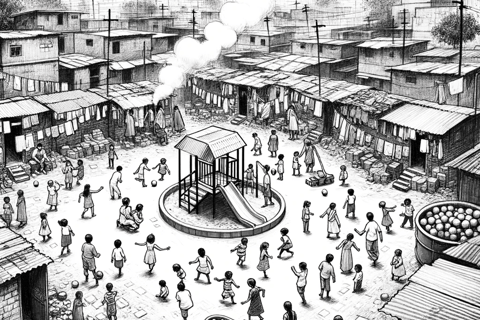Child Safety Across Environments: Challenges and Solutions
Child Safety Across Environments: Challenges and Solutions" offers a comprehensive overview of child safety concerns in various settings such as homes, schools, underprivileged communities, and sports arenas. This blog delves deep into the pressing issues of child abuse and neglect, emphasizing evidence-based strategies and the role of technology in safeguarding young lives. By highlighting both the challenges and potential remedies, it underscores the collective responsibility of parents, educators, policymakers, and communities to ensure a secure environment for every child. Whether you're a parent, educator, or concerned individual, this blog provides valuable insights into creating a safer world for our children.
SOCIAL MEDICINE
10/14/20233 min read


My post content
Child Safety Across Environments: Challenges and Solutions
Child safety and security stands as one of the most pressing concerns of our time. The inherent vulnerability of children to various threats, whether they be physical, emotional, or environmental, demands an immediate and unified response from all stakeholders involved, including parents, educators, policymakers, and communities at large. This article aims to delve deep into the multifaceted aspects of child safety, examining the prevailing challenges and potential solutions, underscored by evidence-based recommendations and the transformative role of technology, especially artificial intelligence (AI).
Child Safety within the Confines of Home
The home, often considered a safe haven, unfortunately, is not immune to the shadows of child abuse. A staggering 80% of child abuse incidents occur within the family, emphasizing the need to pivot the direction of our child safety narratives. The underpinning issue of intrafamilial abuse, coupled with its underreporting, calls for a paradigm shift where children feel emboldened to share their experiences without fearing backlash. Empowering parents with knowledge, bolstering child protection agencies, and galvanizing communities to participate in awareness campaigns are essential facets of a comprehensive strategy that seeks to fortify the child's right to safety and well-being.
The School Environment and Child Safety
Schools, as foundational pillars of a child's developmental journey, bear a significant responsibility in ensuring their safety. Comprehensive safety plans, encompassing emergency protocols, anti-bullying initiatives, and meticulous visitor screening processes, must be instituted. The efficacy of school safety measures, as highlighted in research by Schwebel & McClure (2010), accentuates the importance of a dual approach, addressing unintentional injuries and deliberate harm. Legislation, like the Child Abuse Prevention and Treatment Act (CAPTA), further underscores the need for a robust regulatory framework. Schools, by integrating these facets, can pave the way for an environment that fosters academic growth while prioritizing child safety.
Vulnerable Communities and Child Safety
The intricacies surrounding child abuse prevention in underprivileged communities, like the slums in India, are undeniably complex. Challenges range from logistical issues like inadequate transportation to systemic challenges such as discrimination and lack of safety measures. The role of mandatory reporting laws, as observed in countries including India, becomes paramount. However, their effectiveness hinges on their rigorous implementation, especially in economically marginalized communities. NGOs and government agencies play an instrumental role, not just in abuse identification and reporting, but in crafting environments that deter abuse.


Child Safety in Sports
The realm of sports, while fostering talent and discipline, unfortunately, is not untouched by the menace of child abuse. Research by Singh and Singh (2019) sheds light on both the physical and emotional trauma children can endure. Establishing a culture within sports organizations where reporting abuse is encouraged without fear of retaliation becomes essential. This involves not only policy adaptations but a significant cultural evolution within these organizations.
In conclusion, child safety is a multifarious issue, requiring concerted efforts from all stakeholders. By harnessing evidence-based strategies and the prowess of technology, especially AI, we can aspire to create a world where every child is secure, protected, and valued.
References:
Schwebel, D. C., & McClure, L. A. (2010). School safety interventions: Where are we and where should we go next? School Psychology Review, 39(1), 101-113.
Schwebel, D. C. (2019). Child behavior and environmental factors influencing unintentional injuries. Journal of Pediatric Psychology, 44(6), 631-642.
Peterson, C., & Farmer, E. (2019). Bridging the gap between child injury and child abuse research. Child Abuse Review, 28(4), 251-264.
Child Welfare Information Gateway. (2023). CAPTA: Understanding its implications. Washington, DC: U.S. Department of Health and Human Services.
NIDIRECT. (n.d.). Recognizing signs of abuse in schools. Retrieved from nidirect.gov.uk
Stoltenborgh, M., Bakermans-Kranenburg, M. J., Alink, L. R., & van Ijzendoorn, M. H. (2013). The universality of childhood emotional abuse: A meta-analysis of worldwide prevalence. Journal of Aggression, Maltreatment & Trauma, 22(8), 870-890.
Singh, R., & Singh, B. (2019). Child abuse in sports: An alarming concern. Indian Journal of Community Medicine, 44(Suppl 1), S3.
Paul, V. (2021). Prevention of child abuse in sports: Recommendations for Indian schools. Indian Pediatrics, 58(1), 23-26.






